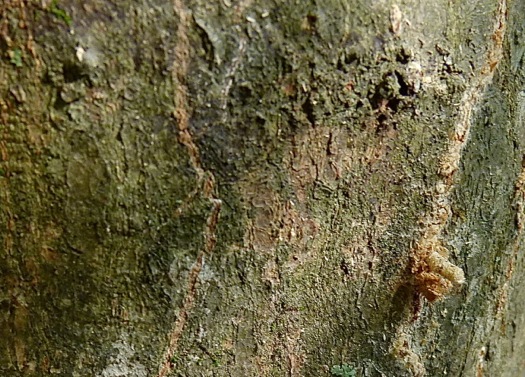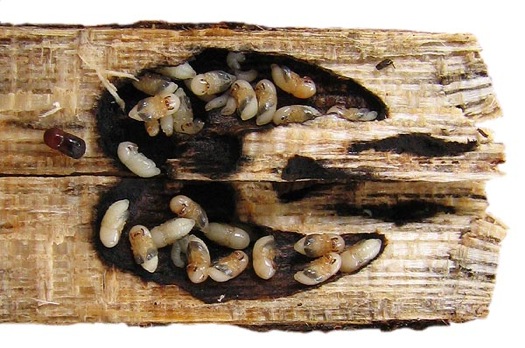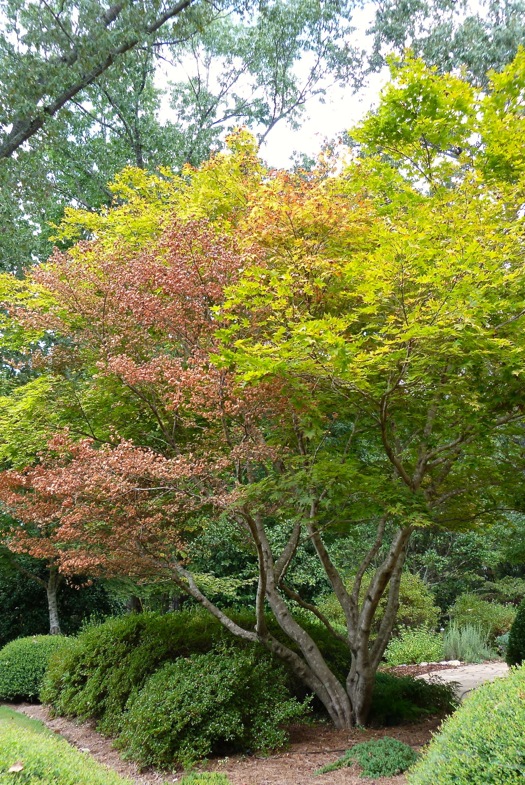Disaster: Ambrosia Beetles in a Special Tree
 Sunday, September 11, 2016 at 4:00PM
Sunday, September 11, 2016 at 4:00PM There is a 26-year old Japanese maple near the house, visible from our dining and living room windows. It is one of several Japanese maple seedlings I planted in 1990 after a tornado devastated our property. It has matured into an astonishing specimen with multi-colored leaves that are breathtaking, especially in fall when they glow with fiery magnificence.
The Japanese maple in front of the house can be seen here, behind the arch in this fall view of the front garden.
It has always been a healthy tree, until last week when I noticed that some of its leaves were dying. At first I attributed this to heat stress, but then I noticed a pile of sawdust at its trunk. Closer inspection revealed unmistakable borer holes, and my heart sank:


I emailed photos to an entomologist at the Plant Diagnostics Lab at Auburn University, and I soon had a grim diagnosis: Granulate Ambrosia Beetle. Most ambrosia beetle species don't ingest wood tissue; instead, the sawdust resulting from their excavation is pushed out of the borer holes, forming little columns of sawdust. This is exactly what is seen on my tree. Females bore into twigs, branches, or small trunks of susceptible woody plants and excavate a system of tunnels. They feed on a symbiotic fungus that they introduce into their tunnels. High humidity promotes reproduction of ambrosia beetles, and we have had a very humid summer. Eggs, larvae, and pupae are found together in the tunnel system excavated by the female.
 Photo of Granulate Ambrosia Beetle with pupae and black fungus. Photo from Wikipedia.This insect usually attacks apparently healthy hardwoods less than 3 inches in diameter, and their appearance in larger wood often is an indication that the tree is highly stressed or dying, although my tree did not appear stressed or dying until this beetle attack. Prognosis is poor. There are no chemicals that one can apply that will kill ambrosia beetles inside a trunk. Systemics will NOT work as the beetles are inside the vascular tissue of the tree.
Photo of Granulate Ambrosia Beetle with pupae and black fungus. Photo from Wikipedia.This insect usually attacks apparently healthy hardwoods less than 3 inches in diameter, and their appearance in larger wood often is an indication that the tree is highly stressed or dying, although my tree did not appear stressed or dying until this beetle attack. Prognosis is poor. There are no chemicals that one can apply that will kill ambrosia beetles inside a trunk. Systemics will NOT work as the beetles are inside the vascular tissue of the tree.
Mine is an older tree with a number of trunks. Since some of the trunks are affected and others not, the entomologist recommends that we remove the infested trunks and dispose of the wood. So this is what we are going to do. It will greatly affect the shape of the tree, and the tree may yet die. More leaves have died in the past few days. One can clearly see which trunks are affected.
More leaves have died in the past few days. One can clearly see which trunks are affected.
This Japanese maple provides filtered shade to nearby azaleas and ferns, and it also keeps hot sun from shining directly into the house. If it dies, I will greatly miss it. However, I have learned to adapt to what nature hands me in the garden. I am already thinking about how I will replace it, if that becomes necessary.
Reader Comments (20)
Yikes! Nasty creatures. I'm sorry that your beautiful maple is seriously at risk, Deb. I hope the surgery works and doesn't destroy the graceful shape of your tree. My fingers are crossed for you!
Darn! That tree is gorgeous too. I'm having a similar problem with my white pine. It's 7 years old, and just getting large and lovely, but I'm fighting a constant battle with pine weevils, which attack the central leader. We've been removing the leader, and training a nearby branch to take over at leader, but every time we do, the weevils just move to that one. And soon it will be too tall to reach with the ladder! I don't think it kills the pine, but it stops it from growing up, and just allows it to grow out into a blob. Ugh.
Oh, dear. It's always sad to lose a favorite plant, especially one that performs such an important role in your garden. I hope you are able to save some of the tree with quick action. Good luck.
Oh no! I hope you're able to save the tree, even if the form is altered.
Oh my :( nasty looking creatures!
so sorry about your beautiful Japanese Maple! I cross my fingers that the surgery will get rid of this pest. Think positive, the tree will survive and with some shaping will have an attractive shape again, soon.
So sorry to hear that, Deb!
I hope the tree survives.
I'm so sorry, Debbie! That is a beautiful tree. I'm just thankful it's not the marriage tree!
Such a sad bit of information, the photos of this tree are so gorgeous.
I am so sorry that your tree has been attacked by those nasty pests. Last year we lost a magnificent Japanese maple to ambrosia beetles. Since then we have our tree company treating our other trees -- cause those buggers will get around! Thanks for your journal. I'm always delighted to see a new post in my email box.
That's really sad Debby; I admire your stoicism in the face of something that can't be changed, I do hope that the rest of the tree can be saved. I know how I felt when I lost all my Boxwood to the Box moth.
Oh, anguish!
I hope you can save a slimmed down version of healthy branches.
Oh this a shame, Deb. I am sorry to hear it. My first thought too was cut the affected branches, but you are going to lose the beauty of that tree's lovely shape. And likely the tree itself.
Oh dear, sorry to hear that! It's always sad to lose a tree, but as you say ... it happens regularly in nature. That is a beauty, so I hope your treatments will work!
What a pity. I hope your beautiful maple will survive.But I am curious to know your thoughts about it's replacement.
You are wise to try to be adaptable. I haven't lost any beloved trees, but I have had to give up my beloved Echinaceas and Hollyhocks because of diseases. Still, it hurts. My condolences.
Oh no! We had Ambrosia Beetles in our fig tree last year. We did exactly what you did, remove the infested branches and hope for the best. The fig seems do be doing okay this year but we'll see how it does long term. Of course, loosing a fig isn't the same as loosing your gorgeous Japanese Maple. I hope it survives, but you certainly have a great attitude about it.
Ooh, yet another pest and disease to have in mind! I am so sorry to hear you might lose that magnificent acer, it will take a long time to grow something in its place that can provide that shade so I hope you will be able to rescue it.
Oh no! It is so sad to possibly lose trees, especially when they take so many years to grow. I hope you can save the rest of the trunks!
How heartbreaking! I have never heard of this beetle before. I hope disposing of the infected wood works.